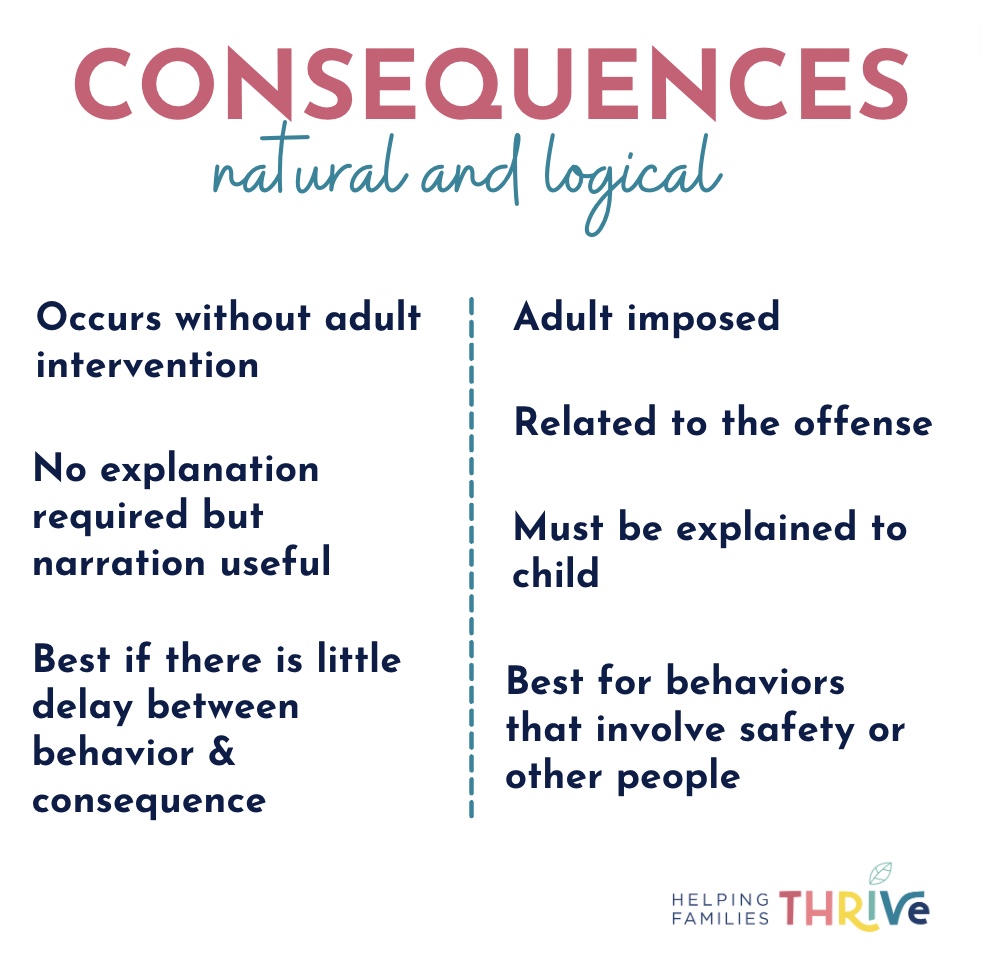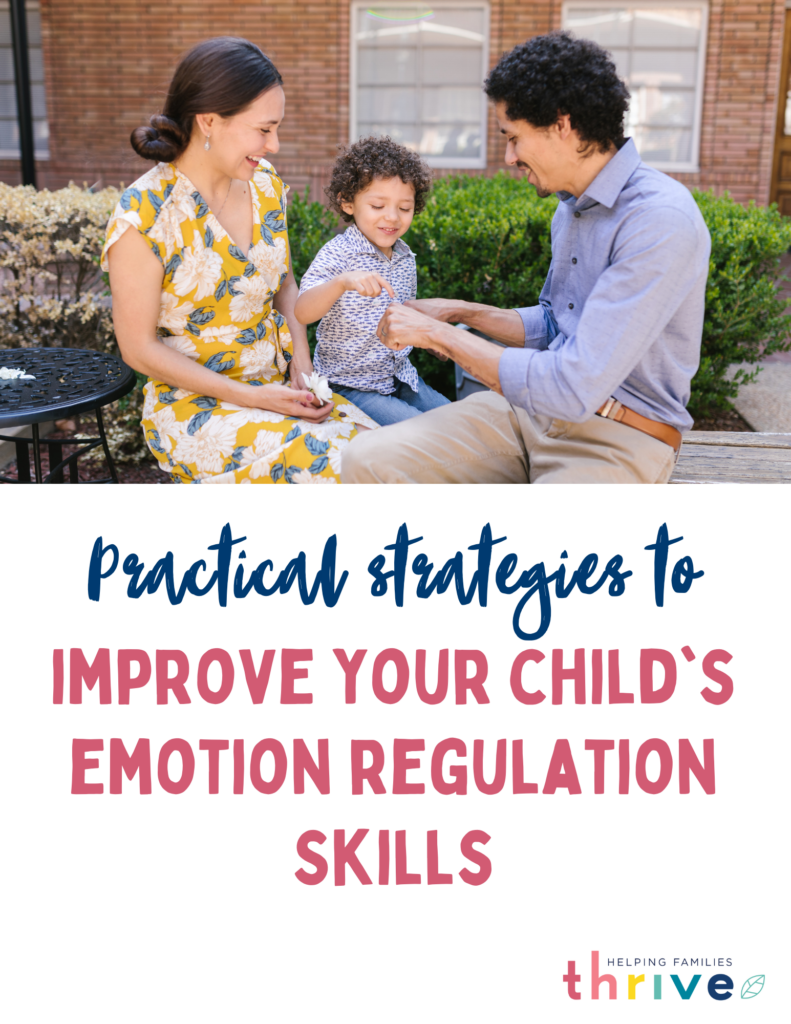
Many parents wonder if and how they should be using consequences or punishments in their parenting. Are they necessary? Will they cause damage to our attachment? There’s lots of conflicting advice online and even from professionals, which can leave parents feeling confused and overwhelmed. Thankfully, we have many, many years of research to help guide our parenting approaches.
Why consequences?
Let’s back up a big before we dive into consequences! All top evidence-based parenting interventions, such as The Incredible Years, begin with strengthening relationships and teaching missing skills. These preventative tools ensure that our children are experiencing a sense of security and have the skills they need to meet expectations. Additionally, kids are more likely to demonstrate positive behaviors, manage their feelings and cooperate with boundaries we set when we are being proactive. However, this does not mean it’s all kumbaya from here!
Sometimes, social media only shows us the positive strategies and leaves out the messier parts. Even the most skilled, positive, and respectful parent will have children who cross boundaries.
Sending the message that if a parent-child relationship is strong enough then behaviors will work themselves out is not only untrue, it elicits damaging parent shame.
We are here to tell you that you are not damaging your child by setting firm limits. Consequence is not a bad word! In fact, a recent research review found that, in addition to building a warm relationship and teaching emotional regulation skills directly, clearly defined logical consequences for negative behavior is critical for children to develop optimal self-regulation skills.
However, there is evidence that the frequency and type of consequences matter. First, when facing a challenging behavior, you want to focus on prevention before jumping straight to responses, such as consequences. This ensures that we don’t over-rely on consequences, which is unenjoyable and ineffective. One way to prevent challenging behaviors is to ensure your child’s emotional piggy bank is full. Second, we want to make sure we are using developmentally appropriate consequences that are backed by science. Natural and logical consequences are highly effective forms of teaching — they are a part of all top evidence-based parenting programs.
You can be a gentle and loving parent and set limits.
What is the goal of consequences?
The goal of consequences is not to make our child feel bad. Rather, the goal is to allow children to experience the results of their choices in a safe and supportive environment. Consequences are very different from harsh punishments. If you find yourself plotting a creative consequence with a feeling of retaliation, it’s best to take a parent break. You can say, “That behavior was not okay. Next time, I need you to XYZ. I am going to take a minute to cool off, and we will talk about it a bit more once we have both chilled out. I love you.”
So while our goal is not to make our child feel bad, this does not mean children will be happy when faced with a consequence they don’t like. A child disliking or being distressed by a consequence doesn’t mean it’s not a positive learning opportunity. When used as part of an overall positive parenting approach, natural and logical consequences are not only effective but actually decrease the likelihood of parents using more harsh, punitive approaches.
Natural and logical consequences
There are two types of consequences that are helpful for learning: natural and logical consequences.
Natural consequences
A natural consequence is when we, the parents, stop reflexively stepping in to save our children from experiencing the results of their choices.
Natural consequences happen when we let the learning opportunity occur without adult intervention.
As long as they are safe, what would happen if we just didn’t interfere?
For example:
- Your child refuses to wear a jacket on short walk. Instead of insisting they wear it, they get chilly.
- Your child didn’t bring an umbrella. Instead of the scrambling back home to get it, your child gets wet.
- Your child forgot homework at home. Instead of emailing the teacher, your child doesn’t turn it in that day.
- Your child didn’t put laundry in the hamper. Instead of picking it up and lecturing later, those clothes don’t get washed by the parent.
Allowing kids to experience the natural consequence of their actions helps them build resilience and become more self-sufficient.
Logical consequences
In some cases, a natural consequence isn’t appropriate, helpful or sufficient. These include:
- If your child’s or another person’s safety is at risk. The natural consequence of running into the street is getting hit by a car. Clearly, that is not an acceptable consequence.
- Situations in which there is too much of a delay in feedback. For example, if you don’t brush your teeth, then you will get cavities in a year.
- When the consequence is too abstract for the child. The natural consequence of being stinky at school is that peers will look at you strangely. For some of our kids, who either don’t notice or understand social cues, they won’t have the opportunity to learn from this uncomfortable consequence and will need more helpful, concrete ways to understand social rules around hygiene.
When a child doesn’t learn from the natural results of their actions, parents step in by using logical consequences.

Components of a logical consequence include:
- Logical. Essentially, the consequence assigned is related to the behavior. This can include loss of a privilege or assigning an additional restorative chore or task.
- The shorter the delay the better. The shorter the time between the consequence and the behavior the more clearly linked the cause and effect will be for your child. This allows our children to experience the consequence but then bounce back to try again. Imagine your child makes a mistake at 9am and then goes on to have a great day only to have a consequence at 5pm. Not only is this going to feel illogical to them, it can be demoralizing. The younger the child, the more incremental/closer in time to the behavior the consequence should be. In general, for school aged children, it is helpful to have consequences occur within 24 hours of the challenging behavior.
- Known ahead of time. It’s important that our consequences are revealed in advance. This can be done as a standing family rule or through the use of an if-then warning (“If you do not put your helmet on, then we will not be able to go on our bike ride.”). This allows our children to adjust their behavior accordingly.
- Respectful. To be respectful, we should state the consequence calmly with reason. “You were unsafe with the truck again. I am going to put the truck away for a few minutes, then you can try again.”
- Incremental and proportionate. We don’t want to “go big or go home” with consequences. That will backfire. Instead, when removing a privilege, remove it in small increments (e.g., remove toy for 5 minutes instead of for a day). This gives kids more learning opportunities and prevents them from feeling discouraged.
Examples of logical consequences:
- Child throws toys = adult removes toys for a short period of time
- Child spills something = they help clean it up
- Child is playing unsafely = they must take a break until calm
- Child doesn’t do homework = they can’t watch shows

If a child is repeatedly bumping into the same consequence, this is an indicator that more prevention strategies are needed. At a calm moment think of some preventative structures you can put in place to help teach a missing skill. For example, for a kiddo who frequently forgets their lunch you put a simple note near the door as a reminder.
Healthy, effective parenting is a balance of warmth and boundaries. Remember, the use of natural and logical consequences is a wise withdrawal from you child’s emotional piggy bank. Your child might be distressed during a consequence, but if your piggy bank is full, your child has the ability to not only withstand the consequence, but to thrive from these learning opportunities.
If you found this helpful, our Essentials eCourse goes into more detail with video examples of many parenting tools to both prevent and respond to challenging behaviors.





